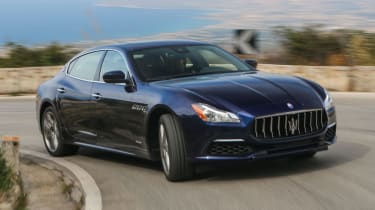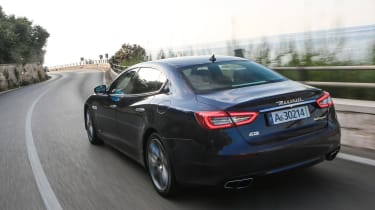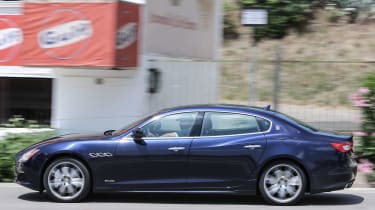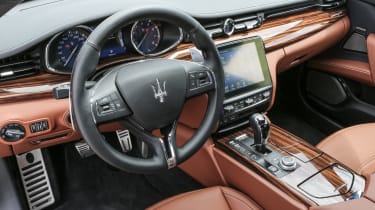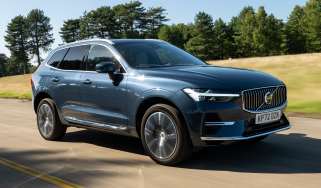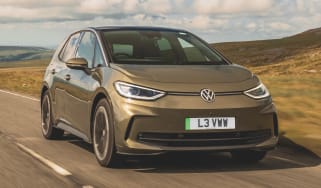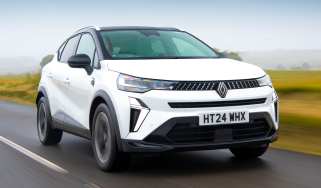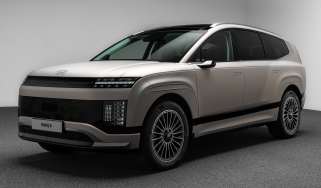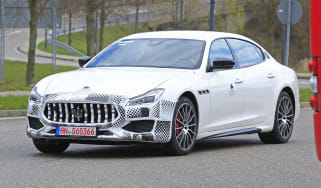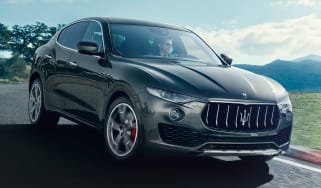Maserati Quattroporte saloon review
“The V8 Maserati Quattroporte is a great driver’s luxury saloon, with sharp handling and blistering performance, but it’s starting to feel its age”
Pros
- Beautiful interior
- Sharp handling
- Seriously fast
Cons
- Pricey to buy and run
- Could be more spacious
- Not as comfortable as some rivals
The Maserati Quattroporte name has graced the brand’s largest and most elegant saloon cars for 50 years. It’s an evocative nameplate, even though Quattroporte merely means ‘four-door’ in Italian, and the car has become a real rival to the BMW 7 Series and Mercedes S-Class.
While it was refreshed in 2020, the big Maserati has been on sale for a few years now and can’t compete with the state-of-the-art S-Class. But if you’re drawn in by the trident badge, it’s very easy to overlook any other luxurious saloon.
The current Quattroporte boasts (alongside its Ferrari-developed V8) more efficient petrol engines than before, although the diesel version has been dropped. While the diesel model was priced more affordably and offered lower running costs, it never seemed to suit the Quattroporte as well as the petrol engines.
It’s been replaced by a range-topping Trofeo model, with a thunderous 572bhp V8 petrol engine. All other versions get a V6 petrol engine, with either 345 or 424bhp, and prioritise power over parsimony. All models continue to enjoy an interior built for luxury and comfort, with wood and leather all around. An extra 107mm has also been added to the passenger compartment, significantly improving the amount of space in the back.
More reviews
In-depth reviews
Despite all this luxury, the Quattroporte has never been ashamed of putting the needs of the driver ahead of cosseting the passengers. This is expressed by the driver-focused dashboard and the way the car rides – it’s more firmly set up than the Mercedes S-Class or Jaguar XJ, and beats the Porsche Panamera, Audi A8 and BMW 7 Series for driver appeal. The Quattroporte is a genuinely fast car, too. All models can easily match the electronically limited 155mph maximum of their German rivals, while even the least powerful model can accelerate from 0-62mph in 5.5 seconds.
Although it doesn’t ride as comfortably as some rivals, the Maserati Quattroporte is well worth considering as an alternative to the German brands if you’re shopping for a big luxurious saloon.
MPG, running costs & CO2
Although still providing a huge 572bhp, the 3.8-litre V8 petrol engine is a massive improvement in terms of fuel economy on the old Quattroporte's 4.7-litre V8. However, it’s still going to cost a lot to tax, fuel and insure. Expect to see 23mpg or less, so you'll be topping up the 80-litre fuel tank regularly and road tax will cost £475 a year for the first five times you renew it. Meanwhile, the smaller 3.0-litre V6 petrol isn’t much less thirsty, and costs the same in tax.
Engines, drive & performance
The range-topping 572bhp V8 engine accelerates the two-tonne Quattroporte from 0-62mph in 4.5 seconds, which makes it the fastest version ever produced - although a BMW M5 is faster still. The V6 ‘S’ model is nearly as quick as the V8, hitting 0-62mph in five seconds, and, apart from not sounding as good, offers most of the performance appeal of the bigger engine. Despite its weight, the Quattroporte feels as light as a feather through corners. Quick changes of direction are easy and the steering reacts fast, helping the car to feel a lot smaller than it actually is.
The now-discontinued 3.0-litre diesel doesn't sound anywhere near as good as the petrols, though, despite an ‘Active Sound’ generator that operates when Sport mode is activated. It’s obviously slower than the petrol, but still puts out a competitive 271bhp and isn’t at all short of pace, managing a 0-62mph time of 6.4 seconds, midway between a BMW 730d and Mercedes S 350d. When we drove the diesel, though, we found it to have a vague response from steering that felt artificially heavy when cornering. This lack of sensation and feeling of kickback on rough surfaces somewhat eroded the driver appeal.
Body control is improved when the Sport suspension mode is selected, but the jiggly ride this brings will probably see you switching back to Normal as soon as the road straightens out.
You sit behind a recently updated dashboard boasting a bigger touchscreen of higher resolution. There are also a variety of driver-assistance systems to call to action. The touchscreen interface is logical and quick to use thanks to its rotary dial system, and it has sharp, attractive graphics, too.
Interior & comfort
The interior of the Quattroporte is now more luxurious than ever before. High-quality leather, wood and metal is the order of the day, and ergonomics have received a lot of attention, so all controls can be found in logical places. It’s just a shame it doesn’t look a little more adventurous, especially when rivals like the Audi A8 and Mercedes S-Class look so special inside.
An extra 107mm in between the front and rear wheels compared to the old model has greatly boosted the amount of space available to rear passengers, with legroom becoming quite generous. However, the elegantly low roofline does mean that headroom in the back is a little limited, so if you’re tall then slouching may be necessary to avoid your head brushing the ceiling.
Those looking for luxury may be disappointed by the car’s ride quality, which deteriorates markedly on poor road surfaces, failing to disguise shocks that would go unnoticed by passengers in an S-Class or Jaguar XJ – a side-effect of the sporty way the Maserati is set up.
However, the seats are very well shaped and cushioned, while improved sound insulation means the Quattroporte is impressively quiet on smooth roads. When considered on its own merits, this is still a comfortable car over long distances.
Practicality & boot space
The latest Quattroporte is a much longer car than the model it replaces, which greatly improves rear legroom and boot space. Passengers in the back seats can stretch out and while a three-seat rear bench comes as standard, alternatively you can choose a more luxurious two-seat set-up with a big centre armrest. The boot can hold 530 litres of luggage – 80 litres more than the old car – and you can fold the rear seats down if you need to carry something larger.
Reliability & safety
Both petrol engines offered in the Maserati Quattroporte were new for this model. That may sound worrying, but millions of miles of testing before going on sale means they'll probably be hardy enough – although Italian cars don't have the best reputation for reliability. Interior quality is impressive, so you won't find any flimsy plastics.
The Quattroporte hasn't been through the Euro NCAP crash tests, but a strong, high-tech body, a long list of active safety systems and a generous amount of airbags mean it's likely to perform well in a crash.

